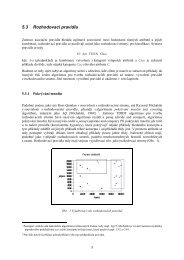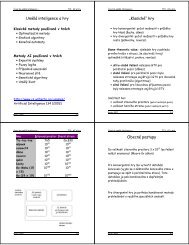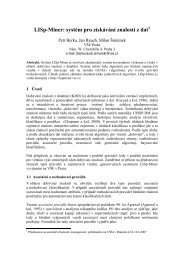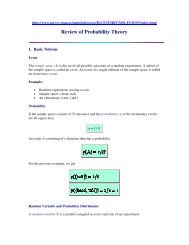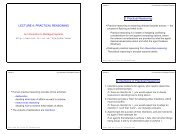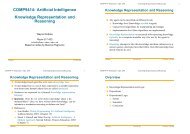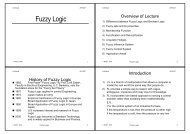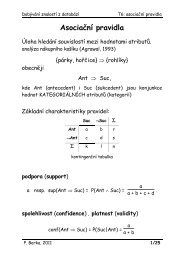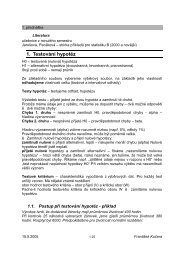COMP9414: Artificial Intelligence First-Order Logic - Sorry
COMP9414: Artificial Intelligence First-Order Logic - Sorry
COMP9414: Artificial Intelligence First-Order Logic - Sorry
You also want an ePaper? Increase the reach of your titles
YUMPU automatically turns print PDFs into web optimized ePapers that Google loves.
<strong>COMP9414</strong>, Wednesday 13 April, 2005 <strong>First</strong>-<strong>Order</strong> <strong>Logic</strong> 2<strong>COMP9414</strong>: <strong>Artificial</strong> <strong>Intelligence</strong><strong>First</strong>-<strong>Order</strong> <strong>Logic</strong>Overview Syntax of <strong>First</strong>-<strong>Order</strong> <strong>Logic</strong> Semantics of <strong>First</strong>-<strong>Order</strong> <strong>Logic</strong> Conjunctive Normal FormWayne WobckeRoom J17-433wobcke@cse.unsw.edu.auBased on slides by Maurice Pagnucco Unification <strong>First</strong>-<strong>Order</strong> Resolution Soundness and Completeness Decidability<strong>COMP9414</strong> c○UNSW, 2005<strong>COMP9414</strong> c○UNSW, 2005 Generated: 13 April 2005<strong>COMP9414</strong>, Wednesday 13 April, 2005 <strong>First</strong>-<strong>Order</strong> <strong>Logic</strong> 1<strong>COMP9414</strong>, Wednesday 13 April, 2005 <strong>First</strong>-<strong>Order</strong> <strong>Logic</strong> 3<strong>First</strong>-<strong>Order</strong> <strong>Logic</strong> <strong>First</strong>-order logic furnishes us with a much more expressive knowledgerepresentation language than propositional logic We can directly talk about objects, their properties, relations betweenthem, etc. Here we discuss first-order logic and resolution However, there is a price to pay for this expressiveness in terms ofdecidability References:◮ Ivan Bratko, Prolog Programming for <strong>Artificial</strong> <strong>Intelligence</strong>,Addison-Wesley, 2001. (Chapter 15)◮ Stuart J. Russell and Peter Norvig, <strong>Artificial</strong> <strong>Intelligence</strong>: AModern Approach, Second Edition, Pearson Education, 2003.(Chapters 8, 9)<strong>COMP9414</strong> c○UNSW, 2005 Generated: 13 April 2005Syntax of <strong>First</strong>-<strong>Order</strong> <strong>Logic</strong> Constant symbols: a, b, . . . , Mary (objects) Variables: x, y, . . . Function symbols: f , mother o f , sine, . . . Predicate symbols: Mother, likes, . . . Quantifiers: ∀ (universal); ∃ (existential)<strong>COMP9414</strong> c○UNSW, 2005 Generated: 13 April 2005
<strong>COMP9414</strong>, Wednesday 13 April, 2005 <strong>First</strong>-<strong>Order</strong> <strong>Logic</strong> 4<strong>COMP9414</strong>, Wednesday 13 April, 2005 <strong>First</strong>-<strong>Order</strong> <strong>Logic</strong> 6Language of <strong>First</strong>-<strong>Order</strong> <strong>Logic</strong>Nested Quantifiers Terms: constants, variables, functions applied to terms (refer toobjects)◮ e.g. a, f (a), mother o f (Mary), . . . Atomic formulae: predicates applied to tuples of terms◮ e.g. likes(Mary, mother o f (Mary)), likes(x, a) Quantified formulae:◮ e.g. ∀xlikes(x, a), ∃xlikes(x, mother o f (y))◮ here the second occurrences of x are bound by the quantifier and yis freeThe order of quantification is very important Everything likes everything — ∀x∀ylikes(x, y) (or ∀y∀xlikes(x, y)) Something likes something — ∃x∃ylikes(x, y) (or ∃y∃xlikes(x, y)) Everything likes something — ∀x∃ylikes(x, y) There is something liked by everything — ∃y∀xlikes(x, y)<strong>COMP9414</strong> c○UNSW, 2005 Generated: 13 April 2005<strong>COMP9414</strong> c○UNSW, 2005 Generated: 13 April 2005<strong>COMP9414</strong>, Wednesday 13 April, 2005 <strong>First</strong>-<strong>Order</strong> <strong>Logic</strong> 5<strong>COMP9414</strong>, Wednesday 13 April, 2005 <strong>First</strong>-<strong>Order</strong> <strong>Logic</strong> 7Converting English into <strong>First</strong>-<strong>Order</strong> <strong>Logic</strong>Scope of Quantifiers Everyone likes lying on the beach — ∀xlikes lying on beach(x) Someone likes Fido — ∃xlikes(x, Fido) No one likes Fido — ¬∃xlikes(x, Fido) (or ∀x¬likes(x, Fido)) Fido doesn’t like everyone — ¬∀xlikes(Fido, x) All cats are mammals — ∀x(cat(x) → mammal(x)) Some mammals are carnivorous — ∃x(mammal(x) ∧ carnivorous(x)) The scope of a quantifier in a formula A is that subformula B of A ofwhich that quantifier is the main logical operator Variables belong to the innermost quantifier that mentions them Examples:◮ Q(x) → ∀yP(x, y) — scope of ∀y is ∀yP(x, y)◮ ∀zP(z) → ¬Q(z) — scope of ∀z is ∀zP(z) but not Q(z)◮ ∃x(P(x) → ∀xP(x))◮ ∀x(P(x) → Q(x)) → (∀xP(x) → ∀xQ(x))<strong>COMP9414</strong> c○UNSW, 2005 Generated: 13 April 2005<strong>COMP9414</strong> c○UNSW, 2005 Generated: 13 April 2005
<strong>COMP9414</strong>, Wednesday 13 April, 2005 <strong>First</strong>-<strong>Order</strong> <strong>Logic</strong> 8<strong>COMP9414</strong>, Wednesday 13 April, 2005 <strong>First</strong>-<strong>Order</strong> <strong>Logic</strong> 10Semantics of <strong>First</strong>-<strong>Order</strong> <strong>Logic</strong>Conversion to Conjunctive Normal Form An interpretation is required to give semantics to first-order logic.The interpretation is a non-empty “domain of discourse” (set ofobjects). The truth of any formula depends on the interpretation. The interpretation provides, for each:constant symbol an object in the domainfunction symbols a function from domain tuples to the domainpredicate symbol a relation over the domain (a set of tuples) Then we define:universal quantifier ∀xP(x) is True iff P(a) is True for allassignments of domain elements a to xexistential quantifier ∃xP(x) is True iff P(a) is True for at least oneassignment of domain element a to x<strong>COMP9414</strong> c○UNSW, 2005 Generated: 13 April 20051. Eliminate implications and bi-implications as in propositional case2. Move negations inward using De Morgan’s laws◮ plus rewriting ¬∀xP as ∃x¬P and ¬∃xP as ∀x¬P3. Eliminate double negations4. Rename bound variables if necessary so each only occurs once◮ e.g. ∀xP(x) ∨ ∃xQ(x) becomes ∀xP(x) ∨ ∃yQ(y)5. Use equivalences to move quantifiers to the left◮ e.g. ∀xP(x) ∧ Q becomes ∀x(P(x) ∧ Q) where x is not in Q◮ e.g. ∀xP(x) ∧ ∃yQ(y) becomes ∀x∃y(P(x) ∧ Q(y))<strong>COMP9414</strong> c○UNSW, 2005 Generated: 13 April 2005<strong>COMP9414</strong>, Wednesday 13 April, 2005 <strong>First</strong>-<strong>Order</strong> <strong>Logic</strong> 9<strong>COMP9414</strong>, Wednesday 13 April, 2005 <strong>First</strong>-<strong>Order</strong> <strong>Logic</strong> 11Towards Resolution for <strong>First</strong>-<strong>Order</strong> <strong>Logic</strong>Conversion to CNF — Continued Based on resolution for propositional logic Extended syntax: allow variables and quantifiers Define “clausal form” for first-order logic formulae Eliminate quantifiers from clausal forms Adapt resolution procedure to cope with variables (unification)6. Skolemise (replace each existentially quantified variable by a newterm)◮ ∃xP(x) becomes P(a 0 ) using a Skolem constant a 0 since ∃xoccurs at the outermost level◮ ∀x∃yP(x, y) becomes P(x, f 0 (x)) using a Skolem function f 0since ∃y occurs within ∀x7. The formula now has only universal quantifiers and all are at the leftof the formula: drop them8. Use distribution laws to get CNF and then clausal form<strong>COMP9414</strong> c○UNSW, 2005 Generated: 13 April 2005<strong>COMP9414</strong> c○UNSW, 2005 Generated: 13 April 2005
<strong>COMP9414</strong>, Wednesday 13 April, 2005 <strong>First</strong>-<strong>Order</strong> <strong>Logic</strong> 12<strong>COMP9414</strong>, Wednesday 13 April, 2005 <strong>First</strong>-<strong>Order</strong> <strong>Logic</strong> 14CNF — Example 1Unification∀x[∀yP(x, y) → ¬∀y(Q(x, y) → R(x, y))]1. ∀x[¬∀yP(x, y) ∨ ¬∀y(¬Q(x, y) ∨ R(x, y))]2, 3. ∀x[∃y¬P(x, y) ∨ ∃y(Q(x, y) ∧ ¬R(x, y))]4. ∀x[∃y¬P(x, y) ∨ ∃z(Q(x, z) ∧ ¬R(x, z))]5. ∀x∃y∃z[¬P(x, y) ∨ (Q(x, z) ∧ ¬R(x, z))]6. ∀x[¬P(x, f (x)) ∨ (Q(x, g(x)) ∧ ¬R(x, g(x)))]7. ¬P(x, f (x)) ∨ (Q(x, g(x)) ∧ ¬R(x, g(x)))8. (¬P(x, f (x)) ∨ Q(x, g(x))) ∧ (¬P(x, f (x)) ∨ ¬R(x, g(x)))8. {¬P(x, f (x)) ∨ Q(x, g(x)), ¬P(x, f (x)) ∨ ¬R(x, g(x))} A unifier of two atomic formulae is a substitution that makes themidentical◮ Each variable has at most one associated expression◮ Apply substitutions simultaneously Unifier of P(x, f (a), z) and P(z, z, u) : {x/ f (a), z/ f (a), u/ f (a)} Substitution σ 1 is a more general unifier than a substitution σ 2 if forsome substitution τ, σ 2 = σ 1 τ (i.e. σ 1 followed by τ) Theorem. If two atomic formulae are unifiable, they have a mostgeneral unifier<strong>COMP9414</strong> c○UNSW, 2005 Generated: 13 April 2005<strong>COMP9414</strong> c○UNSW, 2005 Generated: 13 April 2005<strong>COMP9414</strong>, Wednesday 13 April, 2005 <strong>First</strong>-<strong>Order</strong> <strong>Logic</strong> 13<strong>COMP9414</strong>, Wednesday 13 April, 2005 <strong>First</strong>-<strong>Order</strong> <strong>Logic</strong> 15CNF — Example 2Examples¬∃x∀y∀z((P(y) ∨ Q(z)) → (P(x) ∨ Q(x)))1. ¬∃x∀y∀z(¬(P(y) ∨ Q(z)) ∨ P(x) ∨ Q(x))2. ∀x¬∀y∀z(¬(P(y) ∨ Q(z)) ∨ P(x) ∨ Q(x))2. ∀x∃y¬∀z(¬(P(y) ∨ Q(z)) ∨ P(x) ∨ Q(x))2. ∀x∃y∃z¬(¬(P(y) ∨ Q(z)) ∨ P(x) ∨ Q(x))2. ∀x∃y∃z((P(y) ∨ Q(z)) ∧ ¬(P(x) ∨ Q(x)))6. ∀x((P( f (x)) ∨ Q(g(x))) ∧ ¬P(x) ∧ ¬Q(x))7. (P( f (x)) ∨ Q(g(x)) ∧ ¬P(x) ∧ ¬Q(x)8. {P( f (x)) ∨ Q(g(x)), ¬P(x), ¬Q(x)} {P(x,a),P(b,c)} is not unifiable {P( f (x),y),P(a,w)} is not unifiable {P(x,c),P(b,c)} is unifiable by {x/b} {P( f (x),y),P( f (a),w)} is unifiable byσ = {x/a,y/w}, τ = {x/a,y/a,w/a}, υ = {x/a,y/b,w/b}Note that σ is an m.g.u. and τ = σθ where θ = ...? {P(x),P( f (x))} is not unifiable (c.f. occur check!)<strong>COMP9414</strong> c○UNSW, 2005 Generated: 13 April 2005<strong>COMP9414</strong> c○UNSW, 2005 Generated: 13 April 2005
<strong>COMP9414</strong>, Wednesday 13 April, 2005 <strong>First</strong>-<strong>Order</strong> <strong>Logic</strong> 16<strong>First</strong>-<strong>Order</strong> Resolution Generalised Resolution RuleFor clauses P ∨ Q and ¬Q ′ ∨ R with Q,Q ′ atomic formulaeP ∨ Q¬Q ′ ∨ R❧ ✱❧❧❧❧❧❧✱✱✱✱✱✱(P ∨ R)θ where θ is a most general unifier for Q and Q ′ (P ∨ R)θ is the resolvent of the two clauses<strong>COMP9414</strong> c○UNSW, 2005 Generated: 13 April 2005<strong>COMP9414</strong>, Wednesday 13 April, 2005 <strong>First</strong>-<strong>Order</strong> <strong>Logic</strong> 18Resolution — Example 1CNF(¬∃x(P(x) → ∀xP(x)))1, 2. ∀x¬(¬P(x) ∨ ∀xP(x))2. ∀x(¬¬P(x) ∧ ¬∀xP(x))2, 3. ∀x(P(x) ∧ ∃x¬P(x))4. ∀x(P(x) ∧ ∃y ¬P(y))5. ∀x∃y(P(x) ∧ ¬P(y))6. ∀x(P(x) ∧ ¬P( f (x)))8. P(x), ¬P( f (x))1. P(x) [¬ Conclusion]⊢ ∃x(P(x) → ∀xP(x))2. ¬P( f (y)) [Copy of ¬ Conclusion]3. □ [1, 2 Resolution {x/ f (y)}]<strong>COMP9414</strong> c○UNSW, 2005 Generated: 13 April 2005<strong>COMP9414</strong>, Wednesday 13 April, 2005 <strong>First</strong>-<strong>Order</strong> <strong>Logic</strong> 17Applying Resolution Refutation Negate query to be proven (resolution is a refutation system) Convert knowledge base and negated conclusion into CNF and extractclauses Repeatedly apply resolution to clauses or copies of clauses until eitherthe empty clause (contradiction) is derived or no more clauses can bederived (a copy of a clause is the clause with all variables renamed) If the empty clause is derived, answer ‘yes’ (query follows fromknowledge base), otherwise answer ‘no’ (query does not follow fromknowledge base)<strong>COMP9414</strong>, Wednesday 13 April, 2005 <strong>First</strong>-<strong>Order</strong> <strong>Logic</strong> 19Resolution — Example 2⊢ ∃x∀y∀z((P(y) ∨ Q(z)) → (P(x) ∨ Q(x)))1. P( f (x)) ∨ Q(g(x)) [¬ Conclusion]2. ¬P(x) [¬ Conclusion]3. ¬Q(x) [¬ Conclusion]4. ¬P(y) [Copy of 2]5. Q(g(x)) [1, 4 Resolution {y/ f (x)}]6. ¬Q(z) [Copy of 3]7. □ [5, 6 Resolution {z/g(x)}]<strong>COMP9414</strong> c○UNSW, 2005 Generated: 13 April 2005<strong>COMP9414</strong> c○UNSW, 2005 Generated: 13 April 2005
<strong>COMP9414</strong>, Wednesday 13 April, 2005 <strong>First</strong>-<strong>Order</strong> <strong>Logic</strong> 20<strong>COMP9414</strong>, Wednesday 13 April, 2005 <strong>First</strong>-<strong>Order</strong> <strong>Logic</strong> 22Soundness and Completeness AgainExamples <strong>First</strong>-order resolution refutation is sound, i.e. it preserves truth (if aset of premises are all true, any conclusion drawn from those premisesmust also be true) <strong>First</strong>-order resolution refutation is complete, i.e. it is capable ofproving all consequences of any knowledge base (not shown here!) <strong>First</strong>-order resolution refutation is not decidable, i.e. there is noalgorithm implementing resolution which when asked whether S ⊢ P,can always answer ‘yes’ or ‘no’ (correctly) S = { f (x,g(x)), f (h(y),g(h(z)))}D 0 = {x,h(y)} so σ 1 = {x/h(y)}S 1 = { f (h(y),g(h(y))), f (h(y),g(h(z)))}D 1 = {y,z} so σ 2 = {x/h(z),y/z}S 2 = { f (h(z),g(h(z))), f (h(z),g(h(z)))}i.e. σ 2 is an m.g.u. S = { f (h(x),g(x)), f (g(x),h(x))}...?<strong>COMP9414</strong> c○UNSW, 2005 Generated: 13 April 2005<strong>COMP9414</strong> c○UNSW, 2005 Generated: 13 April 2005<strong>COMP9414</strong>, Wednesday 13 April, 2005 <strong>First</strong>-<strong>Order</strong> <strong>Logic</strong> 21<strong>COMP9414</strong>, Wednesday 13 April, 2005 <strong>First</strong>-<strong>Order</strong> <strong>Logic</strong> 23Unification AlgorithmConclusion The disagreement set of S: Find the leftmost position at which not allmembers E of S have the same symbol; the set of subexpressions ofeach E in S that begin at this position is the disagreement set of S. Algorithm1. S 0 = S, σ 0 = {}, i = 02. If S i is not a singleton, find its disagreement set D i . Otherwise,terminate with σ i as the most general unifier.3. If D i contains a variable v i and term t i such that v i does not occurin t i , thenσ i+1 = σ i {v i /t i }, S i+1 = S i {v i /t i }Otherwise, terminate as S is not unifiable.4. i = i + 1; resume from step 2.<strong>COMP9414</strong> c○UNSW, 2005 Generated: 13 April 2005 <strong>First</strong>-order logic allows us to speak about objects, properties ofobjects and relationships between objects It also allows quantification over variables <strong>First</strong>-order logic is quite an expressive knowledge representationlanguage; much more so than propositional logic However, we need to add things like equality if we wish to be able todo things like counting We have also traded expressiveness for decidability How much of a problem is this? If we add (Peano) axioms for mathematics, then we encounter Gödel’sfamous incompleteness theorem (which is beyond the scope of thiscourse)<strong>COMP9414</strong> c○UNSW, 2005 Generated: 13 April 2005



